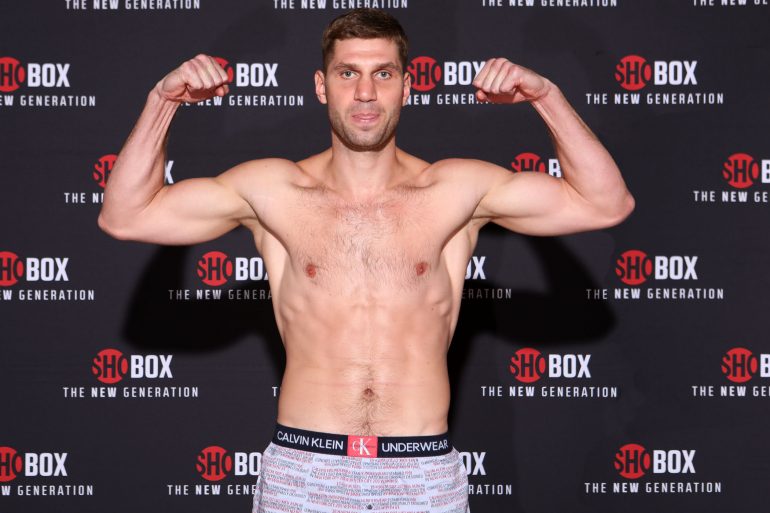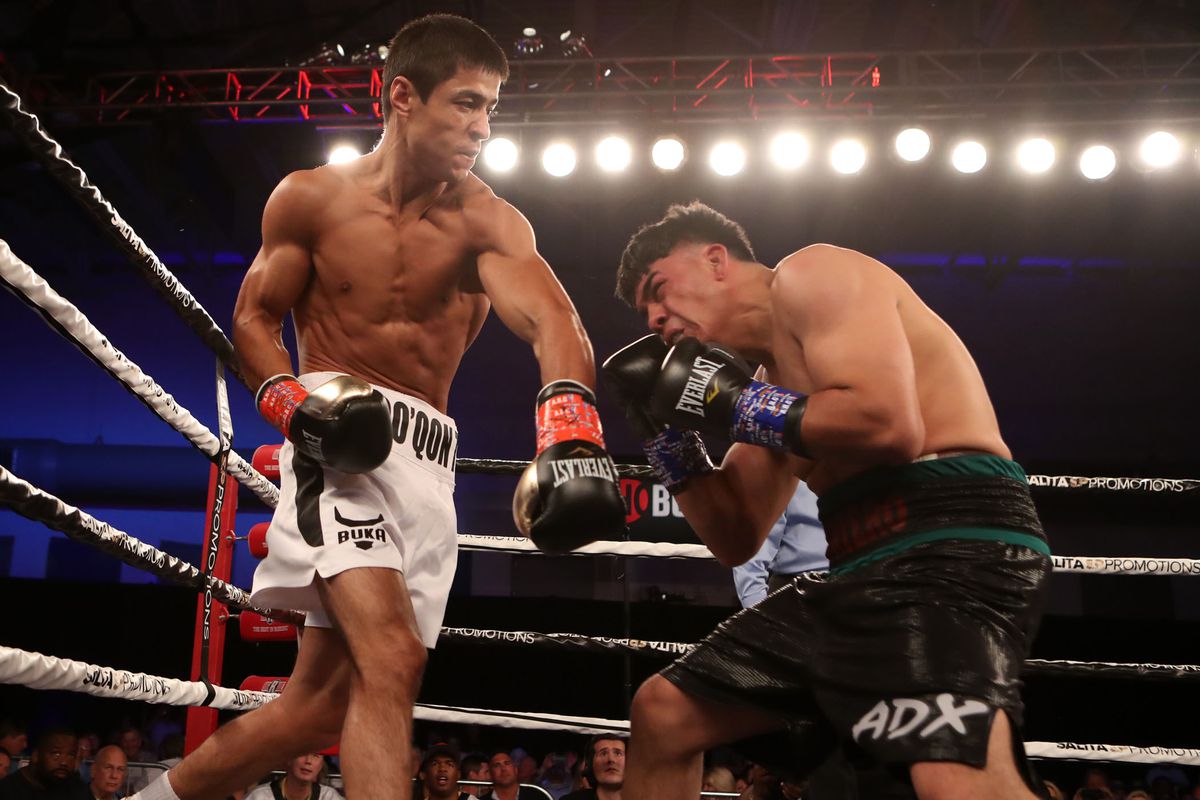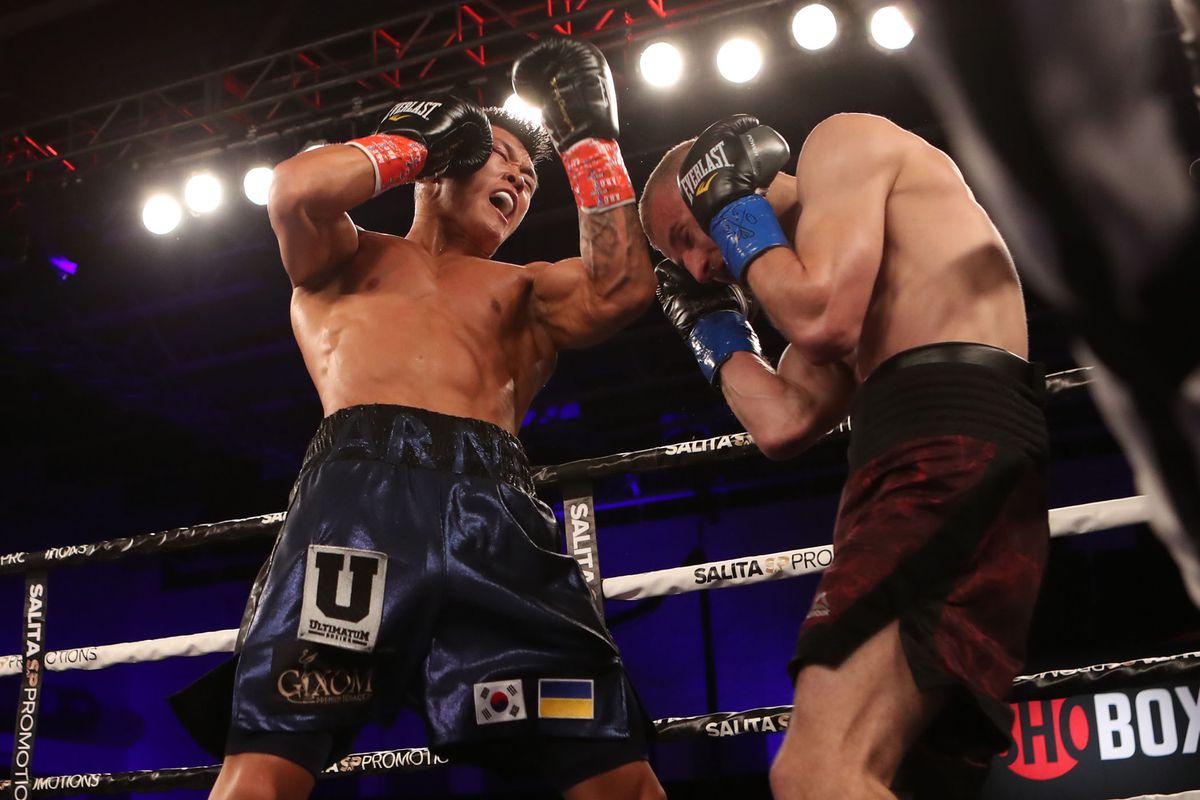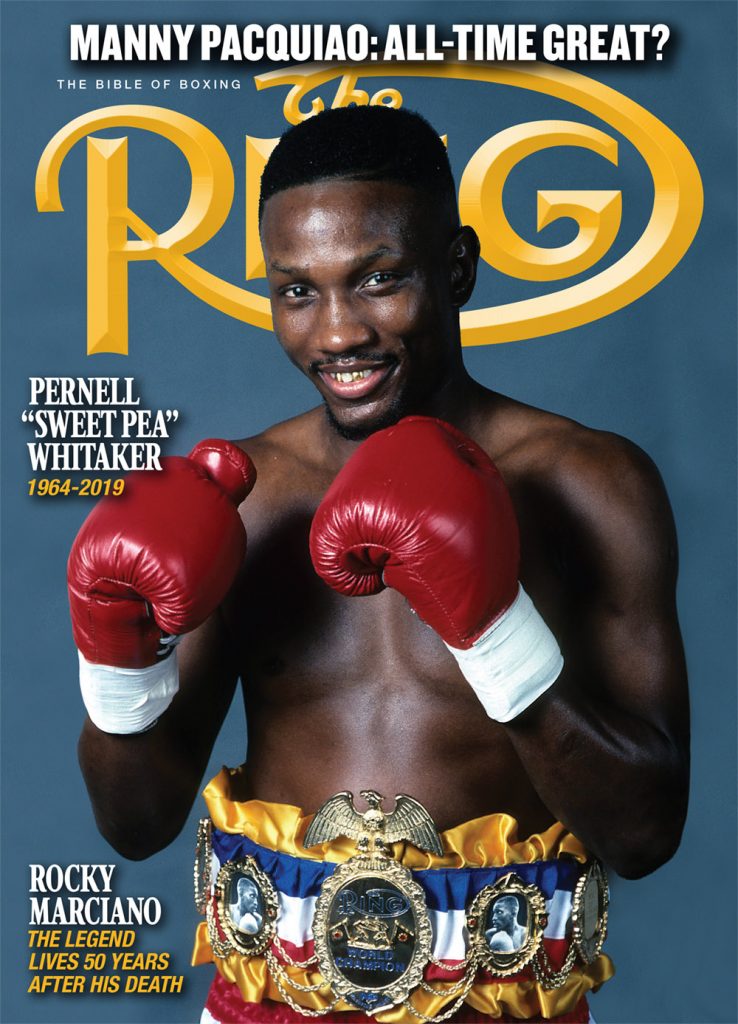The Travelin’ Man goes to Broken Arrow: Part Two

Please click here to read Part One.
Friday, August 23 (continued): Although the mission statement of the “ShoBox” series is to match prospects in theoretical 50/50 fights, the final result occasionally yields a clean sweep of lopsided victories. Such was the case for this tripleheader in Broken Arrow, Oklahoma; not only did all of the perceived “A-side” fighters win, it could be argued that they did not lose any of the 20 rounds that were fought.
The record will state that Arnold Khegai outpointed Vladimir Tikhonov over eight rounds, Shohjahon Ergashev stopped Abdiel Ramirez in four, and, in the main event, Vladimir Shishkin halted DeAndre Ware in eight. However while the winners prevailed in a way that enhanced their standing as prospects, another takeaway for me was that the losers did not dishonor themselves in defeat. While I concentrated on recording the stats for Khegai, Ergashev and Shishkin, I saw enough of Tikhonov, Ramirez and Ware to conclude that their defeats weren’t due to a lack of effort or an insufficient desire to win but because they were in the ring with markedly better opponents.
How much better were the winners than the losers in terms of statistics? Consider:
* The victors out-landed the vanquished 545-227 overall, 117-83 jabs and 428-144 power, which means Khegai, Ergashev and Shiskhin out-landed Tikhonov, Ramirez and Ware by collective per-round margins of 15.9 overall, 1.7 jabs and 14.2 power.
* The collective percentage gaps were equally wide as the winners prevailed 35%-21% overall, 22%-15% jabs and 42%-26% power.
* In terms of landed body punches, the “A-siders” prevailed 161-63, with Khegai leading 19-12, Ergashev 68-22 and Shishkin 74-29.
* Finally when one examines the round-by-round breakdown of total connects – relevant because clean punching is a key judging factor – Khegai, Ergashev and Shishkin completed a 20-0 sweep. The closest Tikhonov came to surpassing Khegai was in the fourth when he was edged out 16-15 while for Ware, the closest approach was when he trailed 18-16 in round one. As for Ramirez, a 31-13 gap in round two was his narrowest gap, which should drive home just how lopsided his fight with Ergashev was.
Seldom have I counted a fight in which one fighter consistently connected with the sickening flushness of Ergashev against Ramirez. Even through my headsets, I could hear the sound of his power shots blasting off Ramirez’s head, which, to me, resembled that of gunshots. And yet, Ramirez absorbed them all with extraordinary grit and while he was given a count in round two, the knockdown, to me, appeared to be more the result of Ergashev’s shove than the left cross that had struck Ramirez a moment earlier.

Shohjahon Ergashev (left) vs. Abdiel Ramirez. Photo credit: Dave Mandel/SHOWTIME
Ramirez’s ability to absorb punishment was no surprise to me because three previous CompuBox-tracked opponents had landed 55.9% of their power shots – a frighteningly high figure. What did surprise me was the completeness of Ergashev’s performance. Before, the jab was a virtual non-factor as it comprised just 7.6% of his total connects in his previously tracked fights but here – albeit against a far shorter opponent who had no choice but to rush him – Ergashev’s jab was a much larger part of his offense as it made up 190 of his 397 total punch attempts (47%) and 30 of his 139 connects (21.6%). That improved jab helped set up flowing combinations that indicated he is not a one-dimensional slugger. Can he apply this multi-layered game to other opponents who aren’t facing five-inch deficits in height and reach? That will be a key to his future success.
It can be argued that Khegai faced the most difficult style of the victorious trio, for Tikhonov is a southpaw points boxer who banks on high volume, a busy jab, mobility and solid technique. While Tikhonov was the busier man (68.5 punches per round to Khegai’s 62.3), his inaccurate jabbing (37 of 285, 13% to Khegai’s 16 of 105, 15%), his inability to hit Khegai hard enough to slow his pursuit and Khegai’s success landing to the body (68-22) virtually sealed his fate. Many young fighters would struggle against a style like Tikhonov’s but Khegai remained composed emotionally and physically compact. It is also worthy of note that both men finished well, for Khegai threw 51 and 68 punches in the first two rounds and 74 and 72 blows in rounds seven and eight while Tikhonov threw 71 punches in each of the first two rounds and averaged 71 in the final two rounds (66 and 76 in rounds seven and eight respectively).

Arnold Khegai (left) vs. Vladimir Tikhonov. Photo credit: Dave Mandel/SHOWTIME
Being a tennis fan – tennis is my No. 2 sport behind boxing – I couldn’t help but take note of Khegai’s grunting after every punch, grunting that brought back memories of Monica Seles and Jimmy Connors, two favorite players of days gone by who performed well at the U.S. Open, which, by the way, begins on Monday.
As for Shishkin, he was simply bigger, stronger, quicker and better than Ware, who pushed Cem Kilic as a late sub before losing by decision in his ShoBox debut and scored an upset majority decision win over Ronald Ellis in his second appearance. The 28-year-old Russian is on the fast track to a title shot and his slashing combinations and command of distance provided evidence of his deep amateur background (a reported 301-29 record) and belied the fact that he was engaging in his ninth professional bout.

Vladimir Shishkin (right) vs. DeAndre Ware. Photo credit: Dave Mandel/SHOWTIME
One key to Shishkin’s victory was his ability to neutralize Ware’s jab. Against Kilic and Ellis, Ware averaged 8.6 jab connects per round – well above the 4.5 super middleweight average – but against Shishkin, Ware averaged just 4.9 compared to Shishkin’s 8.9. The other key was Shiskhin’s body punching, a category Ware needed to dominate. In that department, Shishkin led 74-29 and, from my vantage point, the effects of those body shots eroded Ware’s wind significantly and helped lead to the TKO result.
Combined with his 10th round, one-punch KO of former title challenger Nadjib Mohammedi last October, Shishkin’s victory over Ware stamps him as someone to watch closely on the super middleweight title scene. I was certainly impressed with what I saw and I hope to be at ringside at one of his future fights.
*
With cameraman Gene Samuels not set to leave for the hotel for another 45 minutes, at Gene’s suggestion, I caught a ride back with the broadcast team. Barry Tompkins was the driver; Steve Farhood sat shotgun and I settled into the back seat beside Raul Marquez, who served as our navigator. The drive lasted fewer than 10 minutes and, after saying our goodbyes to Steve and Raul, Barry and I took the elevator up to the fourth floor and returned to our rooms. After finishing my final tasks of the evening – inputting the night’s stats into the master database and sending the fight files off to the Draft Kings people – I turned out the lights shortly after 1 a.m.
Saturday, August 24: After all these years on the road, am I finally getting used to sleeping well away from home or am I just getting older and more tired? Whatever the reason, my five-and-a-half-hour slumber was more than satisfactory and once I finished the morning routines, I spent most of the next three-and-a-half hours polishing Part One and getting a start on Part Two. I received a text from audio man Tim Arden – this morning’s ride to the airport – that we would move up our planned departure from 11:30 a.m. to 11 because that was the hotel’s check-out time. I didn’t mind the change, for while my Tulsa-to-Charlotte flight wasn’t going to depart until 1:44 p.m., I figured I’d use the extra time to get more work done.
After clearing security, however, I received a text from American Airlines that delays associated with my flight to Charlotte threatened my ability to make my connecting flight to Pittsburgh and that it would be best if I explored alternate routes. In response, I walked to Gate A5 – the gate assigned to my Charlotte flight – and asked the agent if she could help me find a new way to the “Steel City.” She said she’d be happy to do so but only after she finished her duties associated with the flight at hand – a 12:24 p.m. flight bound for Chicago’s O’Hare International Airport. That was fine by me; I am a very patient person if I sense that I’m on the road to resolving an outstanding issue and if there is sufficient time at hand. Armed with that mindset, I found a seat and waited my turn.
That turn happened less than five minutes before the flight to Chicago was to officially close. The gate agent summoned me to the desk, searched for alternatives and found none that were easy or convenient. Her assistant, who was a few years younger than she, suggested that I be put on the flight to O’Hare that was about to close.
“Would you have a problem with that?” I was asked.
Normally I would. Chicago is one of the cities I try to avoid because of its history of delayed and canceled flights as well as its nasty weather during the winter months but, here, Chicago seemed to be the very best option. Not only was the plane in question right there, it had plenty of available seats and there were no issues with the connecting flight to Pittsburgh. The connection window was a fairly comfortable 45 minutes and I would land in Pittsburgh by 5:47 – 10 minutes sooner than my original Charlotte flight was to leave for Pittsburgh. Even better: The changes would be completed at no extra charge.
For me, the decision was easy.
“I have no problem with that.”
Because the flight was going to be officially closed in less than two minutes, the older gate agent asked her younger co-worker to execute the necessary keystrokes to change my itinerary and print my new tickets. All was completed in less than 60 seconds and, before I knew it, I was walking down the jetway.
Imagine: Had the hotel’s checkout time been 11:30, Tim and I would not have felt the need to leave earlier and I probably wouldn’t have arrived at the airport in time to book my new way home. To quote the late Rocky Graziano, “Somebody up there likes me.”
Upon entering the cabin, I saw it was half-filled – a very unusual circumstance for me. Although I could have situated myself in any number of seats, I opted to take the one assigned to me – an aisle seat at row nine. I greeted my seatmate – a young blonde millennial – with a breezy “Hello, neighbor,” but instead of getting the usual smile, I received a mild glare and a brief complaint that I chose to sit beside her instead of taking one of the empty seats. She then turned her attention back to the game of solitaire she was playing on her tablet.
“How rude,” I thought. But why make the situation worse by firing back in kind? Instead, I put my clothes bag in the closest available overhead bin (in row 11), dug out a book (NFL legend Bruce Matthews’ biography titled “Inside the NFL’s First Family: My Life of Football, Faith and Fatherhood”) and began reading.
Incidentally the dynamic between me and my seatmate improved. Following the beverage service, I looked over and asked if she was winning her game. This time, she smiled and said that sometimes she was and sometimes she wasn’t. “It’s just my way of passing the time,” after which she let out an uncomfortably long and somewhat nervous laugh. I chuckled a bit in reply and thought, “Well, at least she’s not annoyed with me anymore; I’ll just take my gains and walk away from the table.” The rest of the flight was completed in contented silence.
The plane touched down at 1:50 p.m. CDT, well before the advertised arrival time, and I caught another big break when I discovered that my connecting gate was less than 300 feet away from my arrival gate. (A note: My gate in Chicago was L8 – which, when said quickly, sounds like “late.”) Thankfully I wasn’t late at the gate; in fact, I had plenty of time to make progress on my work, which, happily, I did.
My change in itinerary placed me in an excellent location – the first row behind the first-class cabin. The reason: Leg room that would have made Shaquille O’Neal happy. My seatmate was a 60-something woman who has been a professional caretaker since her teens, a profession that seemed perfectly suited for her positive attitude and gentle demeanor. Unlike my seatmate for the Tulsa-to-Chicago leg, she and I chatted all the way to Pittsburgh and we promised to stay in touch. I never would have met her had it not been for the good fortune I received in Tulsa and she, in turn, would not have met me had her original Southwest flight to Pittsburgh not been canceled.
The aircraft touched down at 5:30 and I arrived home shortly before 8:15. It didn’t take long for me to discover that I needed to address several work-related questions as well as take care of some requests from CompuBox president Bob Canobbio, all of which I completed before retiring for the night.
Although I love to travel, I also appreciate the fact that my next scheduled trip won’t be until late September. As of this writing, I am scheduled to fly to Midland, Texas, which, like Broken Arrow, is a new city for me. I also will have a new punch counting partner in Ben Chan, an ultra-marathon enthusiast whose feats of stamina are beyond my comprehension. Ben and I are scheduled to chronicle a “ShoBox: The New Generation” tripleheader topped by Michael Dutchover-Thomas Mattice and supported by Ruben Villa-Jose Vivas and Brandun Lee-Nick LeLoma.
Until then, happy trails!
*
Lee Groves is a boxing writer and historian based in Friendly, West Virginia. He is a full member of the BWAA, from which he has won 16 writing awards, including two first-place awards, since 2011. He has been an elector for the International Boxing Hall of Fame since 2001 and is also a writer, researcher and punch-counter for CompuBox, Inc. He is the author of “Tales from the Vault: A Celebration of 100 Boxing Closet Classics” (available on Amazon) and the co-author of the newly released book “Muhammad Ali: By the Numbers” (also available on Amazon). To contact Groves about a personalized autographed copy, use the email [email protected] or send him a message via Facebook.
Struggling to locate a copy of The Ring Magazine? Try here or
Subscribe
You can order the current issue, which is on newsstands, or back issues from our subscribe page.















